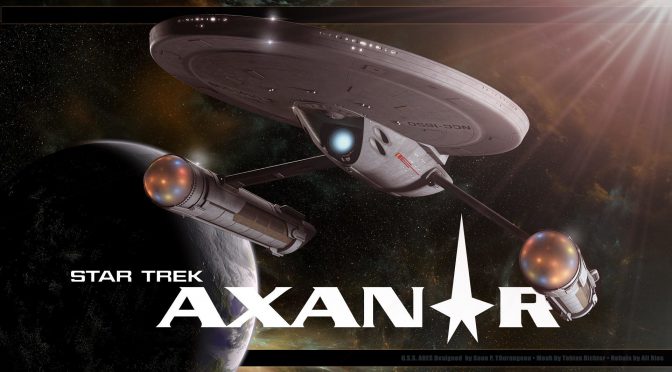As I mentioned before, I rarely understand hostility towards fan productions. So long as they aren’t making a profit and aren’t doing something that negatively impacts your own work, the idea of a fan going out of their way to honor your work seems like a wonderful thing. Some properties are even kept alive by the passion of such fans, kept afloat between major productions by the fact people just genuinely love them. Allowing these people to trade creations and nerd-out together only means you have that fan-base still happy when you’re ready to show them a new installment.
The two biggest names of Sci-Fi today, Star Trek and Star Wars, easily demonstrate this. In Star Wars case, the expanded universe and the continued support by convention goers allowed the franchise to go on hiatus for 16 years before the Phantom Menace came back and was an instant blockbuster. In fact, despite their protests, Star Wars fan loyalty has meant that not a single Star Wars film has been a commercial flop – even as they’re decried for ruining childhoods. And Star Trek? They owe way more to the fans than Star Wars could ever hope to.

Many people don’t realize this today, seeing as most on the internet weren’t around for when the original series first came out, but Star Trek didn’t actually do that great in the 60s. Starting off with relatively soft ratings to begin with, it spent the first two seasons slowly heading towards cancellation. In fact, by the end of Season 2, William Shatner was already planning to jump ship to other projects. The only reason you know of the show today is because as that second season came to a close and was about to be cancelled, the fans began an overwhelming and surprising letter writing campaign to get a third season.
The fans saved the entire franchise, getting not only that third season but eventually the movies and future series installments. And for their efforts, in recent years, they’ve been getting a little… slapped in the face.
Of Paramount’s Importance

Tensions have been high between some Trekkies and the studios that owe them so much. Despite the fact the fan base has been the primary reason the franchise still exists at all, the studio attitude towards them has been perceived by a large contingent as lukewarm at best. Starting with the reboots, vocal Trekkies have had a distinct impression that the films weren’t really meant for them. The inclusion of Leonard Nimoy in the first was enough to make some of them give the new movies a chance, but large parts of the community as a whole still remained fairly critical of what they were getting. And, with the release of Into Darkness, many of those vocal fans expressed that one plot element in particular was disrespectful to the history of the franchise.

And, sadly, it’s been starting to look like those fans were partially right. Though JJ Abrams has been blamed largely for the direction of the new films, it’s been becoming more apparent that the studio was behind it all along. As Simon Pegg stepped up to write the third entry in the so called “Kelvin Timeline”, Star Trek Beyond, he started to say some things that confirmed a few fears the fans had been having in the last few years. Most notably, Pegg expressed fears that earlier drafts of the scripts were rejected by the studio for being “too Star Trek-y” and saying the script needed to be essentially watered down to get approved. For fans of “Star Trek”, the idea that a Star Trek movie could be too Star Trek was understandably discouraging.
Still, the fact that there would be more Star Trek was promising, especially with a new series coming to CBS’ streaming service. Even if it lacked some of the emotional and philosophical depth of the earlier entries, a new Star Trek is rarely something a Trekkie will turn down. And, at the very least, they could still appreciate the old works by doing their own fan productions in the meantime. With luck, the new series coming out in 2017 would have more to offer them. Star Trek Beyond might not be meant for them, and that’s disappointing, but it wouldn’t have been the first time Trekkies and the Studios saw things very differently. So they would just go on and make their own while waiting to see if the studios would turn around.
And then Axanar happened.

Axanar, the mother of all fan-film productions for some fans, was probably the straw that broke the camel’s back. Featuring the talents of passionate fans, industry professionals, and even some people involved in the original franchise – the production started a successful crowdfunding campaign that allowed them to bring a big budget look to an independent fan-film, Axanar was some Trekkies’ wet dream. The early trailers were polished, provocative, and different from anything they’d seen out of CBS or Paramount in recent years. It wasn’t exactly like the original franchise, but it felt like it had the weight of it. If Star Trek Beyond turned out to be a film not meant for them, at least Axanar would be.
Unfortunately, that was the problem. Understandably feeling their IP threatened by this production suddenly raising millions in crowdfunding, the studios had gone from seemingly ignoring the fact the fans exist to suing the ever-loving crap out of them with what some perceived to be all the greedy zeal of a Ferengi quoting the rules of acquisition.

And it took a lot of people by surprise. Sure, Axanar skirted some of the rules by raising so much money through crowdfunding, but they were ostensibly still remaining non-profit and making no commercial offerings (though that is up for debate given some merchandising was starting to happen). They were but one of many fan-films to have been created and all had been considered okay up to that point. Paramount and CBS had the right to make them cease and desist, of course, but they went straight to lawsuit and the fan community was left reeling as a result. After a few months of tension, the situation seemed resolved when people on the professional side came forward and said the studio shouldn’t be doing this. JJ Abrams, once blamed for several problems, was now the guy who was on the fans’ side. Axanar’s lawsuit was ostensibly dropped (but not really) and the studios went on to write up some guidelines on what was and wasn’t acceptable by a fan production.
And, unfortunately, those guidelines are draconian. Defining what you can do, what you can do it with, and how long it can be – there are few aspects of a fan production not controlled by these guidelines. Fan productions are no longer allowed to recreate scenes from the original works, for instance, something that quite a few fan productions had done. If they wear or use props and costumes from the original franchise, they have to be from official sources (which can get expensive). No one can be involved in the project if they’ve ever been involved in the original, eliminating cameos that were previously seen as one of the great fan-film highs. And these “films” are now only allowed to be 15 minutes long at a time and not part of any series that goes on longer than 2 entries totaling 30 minutes or less.

But for all that’s gone wrong in their guidelines, I think the one that’s going to come back to haunt them is their ban on professionals. The meaning was clearly aimed at preventing another Axanar from happening, avoiding any chance someone from their productions could go and show them up independently. But in the process of banning those people they also said that no one involved could be a professional – not just associates of CBS or Paramount. This means that the kind of talent that goes into the production of something like Axanar, which is what threatened them in the first place, would be banned from ever putting that sort of attention to their property again.
Anyone can understand why Paramount would want to do that, but the move is still a mistake in my opinion. For as much as something like Axanar is a threat to them, the truth is that they aren’t going to keep talented professionals from bringing their ideas to fruition. Sure, the ideas they have will need to change, get a few tweaks, but they’ll still come out. And when they do come out, thanks to these guidelines, those ideas are going to be something Paramount should be far more afraid of than anything Axanar could have done. Now that their own guidelines have forced it to happen, the fan-base that once was willing to devote a great deal of time to paying homage to them will now become their competition. And the fact of the matter is, if Axanar was something that threatened them, an Axanar-like project capable of turning a profit should be an even bigger threat.
Some people in the fan community are angry at the Axanar guys for these guidelines. They think that the whole situation never would have happened if Axanar hadn’t overstepped some boundaries and broke unspoken rules. But if the Axanar guys are to be believed they weren’t doing something insidious, they weren’t trying to make things worse for everyone else. They, like most of the Star Trek fandom, just wanted to put their spin on a franchise they love. Paramount and CBS are the ones who chose how they would react. They’re the ones who are stifling the fan community while appearing to be chasing the mainstream. And, as a result, Star Trek fan films are going to suffer. But, mark my words, give it a couple years…
And you’re going to see something like this under a different title.
(I write novels. Someday, I might get fan-fiction. Until that day, I’m just happy to hear back from people on Twitter.)







